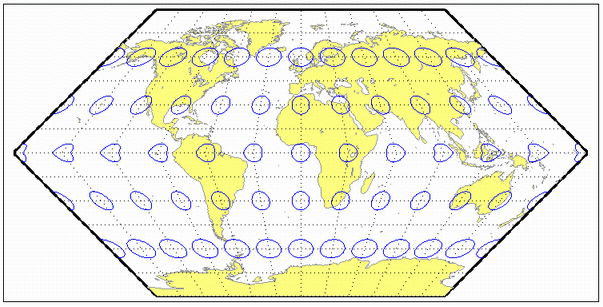eckert1
Eckert I Projection
Classification
Pseudocylindrical
Identifier
eckert1
Graticule
Central Meridian: Straight line half as long as the Equator.
Other Meridians: Equally spaced straight converging lines broken at the Equator.
Parallels: Equally spaced straight parallel lines, perpendicular to the central meridian.
Poles: Lines half as long as the Equator.
Symmetry: About the central meridian or the Equator.
Features
Scale is true along the 47º10' parallels and is constant along any parallel, between any pair of parallels equidistant from the Equator, and along any given meridian. It is not free of distortion at any point, and the break at the Equator introduces excessive distortion there; regardless of the appearance here, the Tissot indicatrices are of indeterminate shape along the Equator. This novelty projection is not equal-area or conformal.
Parallels
For this projection, only one standard parallel is specified. The other standard parallel is the same latitude with the opposite sign. The standard parallel is by definition fixed at 47º10'.
Remarks
This projection was presented by Max Eckert in 1906.
This implementation of the Eckert I projection is applicable only for coordinates that are referenced to a sphere. If you want to project coordinates that are referenced to an ellipsoid, using the
projfwdorprojinvfunctions, then create aprojcrsobject instead of a map projection structure. You can create aprojcrsobject for the Eckert I projection using the ESRI authority code 54015. For example:projcrs(54015,'Authority','ESRI').
Example
landareas = shaperead('landareas.shp','UseGeoCoords',true);
axesm ('eckert1', 'Frame', 'on', 'Grid', 'on');
geoshow(landareas,'FaceColor',[1 1 .5],'EdgeColor',[.6 .6 .6]);
tissot;
Version History
Introduced before R2006a